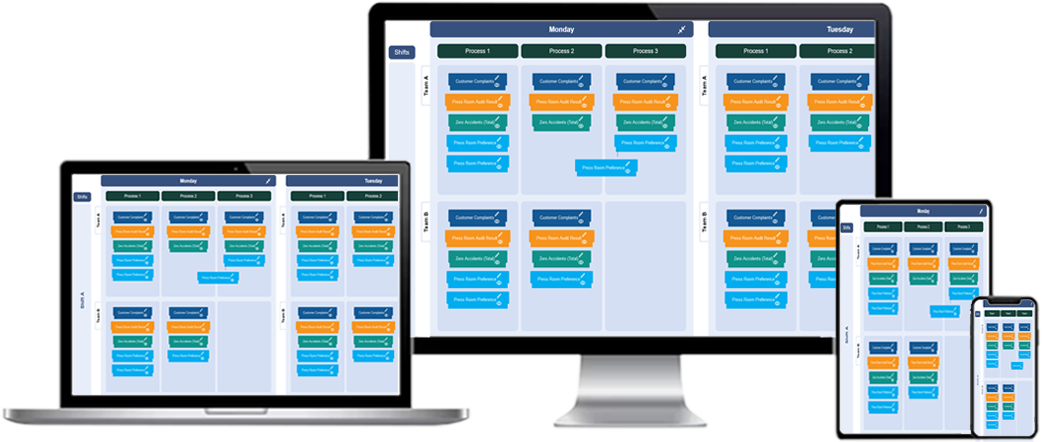In the HVAC industry, managing service requests, technician schedules, and maintenance tasks efficiently is crucial for operational success. T Card software provides a digital solution to streamline job tracking, optimize workflow, and improve service delivery. By replacing manual processes with a centralized, visual management system, HVAC businesses can enhance productivity and reduce downtime.

1. The Role of TCard Software in HVAC Operations
T Card software is a digital adaptation of traditional T Card boards, offering a structured approach to managing HVAC tasks. It provides real-time visibility into job statuses, technician assignments, and pending service requests. This allows managers to allocate resources effectively, ensuring that urgent maintenance and installations are completed on time.
2. Key Features of TCard Software for HVAC Businesses
- Real-Time Job Tracking: Monitor ongoing and completed tasks instantly.
- Automated Scheduling: Assign jobs based on technician availability and location.
- Customizable Workflows: Adapt the system to match specific HVAC service processes.
- Cloud Accessibility: Access and update tasks from any device, improving remote workforce coordination.
- Performance Analytics: Generate reports on job completion times and technician efficiency.
3. How to Implement TCard Software for HVAC Workflow Optimization
Step 1: Define Your HVAC Workflow
Identify key processes such as installation, maintenance, emergency repairs, and inspections. Categorize tasks to ensure proper organization within the T Card system.
Step 2: Configure Digital T Cards
Customize T Cards to include:
- Job Description
- Priority Level
- Assigned Technician
- Location Details
- Expected Completion Time
Step 3: Automate Job Assignments
Utilize automated scheduling features to assign jobs based on technician expertise and availability, ensuring balanced workloads and timely service.
Step 4: Enable Mobile Access
Ensure technicians can update job statuses, upload service reports, and communicate with dispatchers through mobile-friendly software.
Step 5: Analyze Performance and Optimize Operations
Use analytics to track service efficiency, identify bottlenecks, and improve response times for customer requests.
4. Benefits of Using TCard Software in HVAC
- Increased Efficiency: Minimize delays by ensuring smooth job scheduling and execution.
- Better Resource Management: Allocate technicians effectively to optimize workload distribution.
- Improved Customer Satisfaction: Faster response times and streamlined processes enhance service quality.
- Reduced Administrative Work: Eliminate paperwork and manual tracking with a digital system.
- Scalability: Adapt to business growth by managing multiple teams and locations effortlessly.
5. Future of TCard Software in HVAC Industry
With advancements in automation, artificial intelligence, and IoT integration, T Card software is set to become even more powerful. Features like predictive maintenance alerts, AI-driven scheduling, and real-time asset tracking will further enhance HVAC operations.
Implementing the right T Card software enables HVAC businesses to operate efficiently, reduce costs, and improve overall service delivery, making it an
Best T Card Software for HVAC Industry
What is T Card software for the HVAC industry?
T Card software is a task management tool designed to track, schedule, and manage HVAC operations efficiently.
How does T Card software benefit HVAC businesses?
It enhances job tracking, reduces downtime, improves scheduling, and streamlines communication between teams.
What key features should T Card software have for HVAC operations?
Essential features include job scheduling, task tracking, inventory management, real-time updates, and reporting.
How does T Card software help with job scheduling in HVAC?
It organizes job assignments, ensuring tasks are distributed efficiently based on priority and availability.
Can T Card software track HVAC maintenance tasks?
Yes, it helps monitor and log maintenance activities, ensuring timely service and preventive maintenance.
How does T Card software improve team communication?
It centralizes job updates, task assignments, and notifications, keeping all team members informed.
What role does T Card software play in HVAC inventory management?
It tracks stock levels, alerts when supplies are low, and ensures necessary parts are available for jobs.
Can T Card software integrate with other HVAC management systems?
Yes, it can connect with ERP, CRM, and field service management tools for seamless operations.
How does T Card software help reduce downtime in HVAC services?
By improving scheduling and resource allocation, it ensures jobs are completed on time without delays.
Does T Card software support mobile access for field technicians?
Yes, many T Card systems offer mobile access, allowing field technicians to update job status on the go.
What are the reporting capabilities of T Card software for HVAC?
It provides insights into job completion rates, efficiency metrics, and performance trends for better decision-making.
How does T Card software assist in compliance and safety tracking?
It helps log safety inspections, track compliance records, and ensure regulatory standards are met.
Is T Card software customizable for different HVAC workflows?
Yes, it can be tailored with custom workflows, task categories, and automation rules to suit business needs.
How does T Card software help improve customer service in HVAC?
It ensures timely service completion, tracks job history, and enhances communication with customers.
What are the benefits of using digital T Card software over traditional methods?
Digital T Card software offers automation, real-time updates, improved tracking, and reduced paperwork.